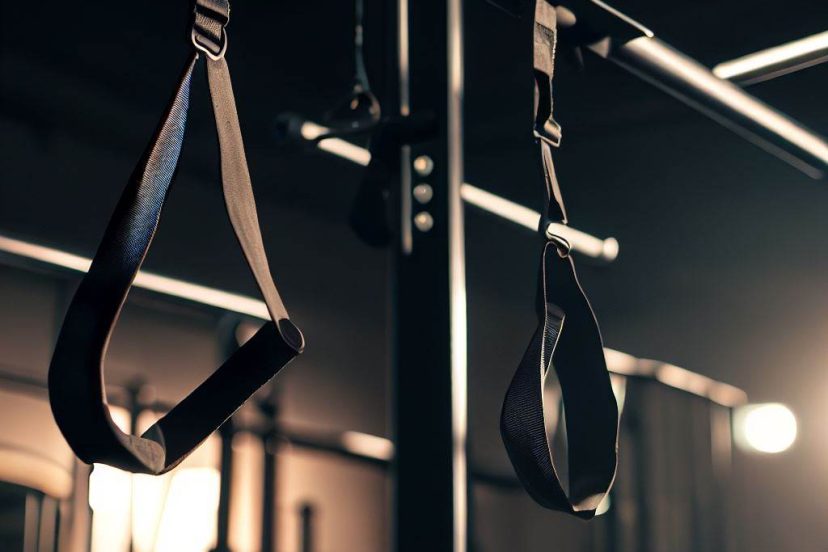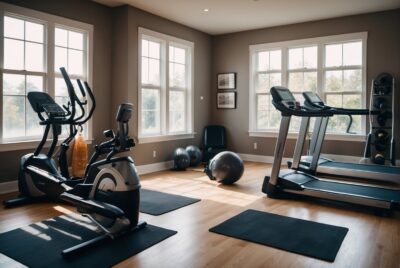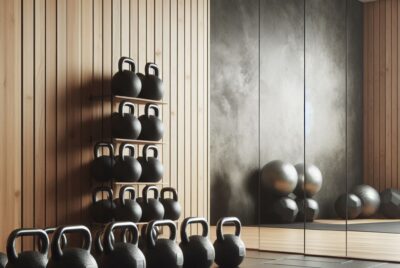Calisthenics Equipment Essentials for Effective Home Workouts
*We may earn a commission for purchases made using our links. Please see our disclosure to learn more.
Calisthenics Equipment Essentials for Effective Home Workouts
Calisthenics is a form of strength training that uses one’s own body weight to build muscle and increase flexibility. This type of workout is convenient, as it often requires minimal equipment, making it an excellent choice for those looking to exercise at home or without access to a full gym. The right equipment can enhance a calisthenics routine, providing both beginners and advanced practitioners with effective tools to vary their workouts and challenge their body in new ways.

From my experience, some key pieces of equipment are valuable additions to any home gym geared towards calisthenics. Pull-up bars, for example, are essential for upper body exercises such as pull-ups and chin-ups. Similarly, equipment like parallel bars and gymnastic rings offer a range of exercises to strengthen the arms, chest, and core. These items are adaptable for athletes of all levels, supporting a broad range of exercises that can progress in difficulty as strength and skill increase.
Investing in calisthenics equipment is about more than just the gear; it’s about investing in the versatility of my workout regimen. Additional items like resistance bands and ab rollers can complement the traditional calisthenics exercises, providing resistance and aiding in core development. Understanding the variety of equipment available and how they can be utilized to target different muscle groups allows me to create a comprehensive workout plan that is both challenging and rewarding.
Essential Calisthenics Equipment

In my experience, there’s a set of core equipment that’s essential to calisthenics, mostly due to their versatility and the range of exercises they enable.
Pull-Up Bars
Pull-up bars are the foundation of any calisthenics home gym. The standard doorway pull-up bar can be installed without screws and is ideal for exercises such as pull-ups and chin-ups. For those seeking greater stability and versatility, wall-mounted bars or free-standing towers can support a wider range of movements and provide more security for intensive workouts. The main benefits of pull-up bars include their ability to work a broad set of muscles like the back, shoulders, and arms, and their variety: supinated, pronated, and grips of various widths.
Parallettes
Parallettes are low bars that provide clearance off the ground and are perfect for push-ups, L-sits, and handstands. A key feature of parallettes is that they often require balance and stability, thus engaging the core muscles extensively. They come in different sizes, with some being small enough for portability, while others are more substantial to support your full weight during dips and more advanced calisthenics movements.
Gymnastic Rings
Gymnastic rings, typically made from wood or plastic, offer a dynamic and challenging component to a calisthenics routine. They can be suspended from a ceiling, a sturdy bar, or even outdoors on a tree branch. Rings are the pinnacle of calisthenics equipment due to their instability, which forces you to engage more muscle groups to maintain balance. Exercises like ring dips, muscle-ups, and the ever-challenging iron cross are all performed on gymnastic rings. This piece of equipment can significantly enhance the intensity and effectiveness of your upper body and core workouts.
Weighted Calisthenics Equipment

In calisthenics, incorporating weighted equipment can significantly enhance strength and muscle development. These tools add resistance, providing a fresh challenge to the body.
Weighted Vests
I find that weighted vests are a versatile and effective option for adding resistance to calisthenics. Designed to distribute weight evenly across my torso, a weighted vest integrates seamlessly with my movements, maintaining my body’s natural center of gravity. This allows me to perform a range of exercises like pull-ups and push-ups with added resistance to develop muscle and strength.
Dumbbells
Dumbbells, though traditionally used in weightlifting, have a place in calisthenics for targeted muscle work. By holding dumbbells during squats or lunges, I can intensify the workout for my lower body. Similarly, incorporating them into upper-body calisthenic exercises, such as burpees, enhances the challenge for my arms, shoulders, and chest.
Ankle Weights
Lastly, ankle weights add resistance to lower-body calisthenics, which is especially beneficial for exercises focused on the legs and core. When I strap them on for leg raises or flutter kicks, I notice a significant increase in the demand placed on my muscles, encouraging strength gains in a controlled and focused manner.
Support and Safety Gear

Choosing the right support and safety gear is crucial to enhance performance and prevent injury during calisthenics workouts. Here, I’ll discuss the importance of gloves and wrist wraps, which are key elements for safeguarding your hands and wrists, allowing for a more effective and secure workout session.
Gloves and Grips
I recommend using gloves or grips for calisthenics to protect your hands and improve your grip. Workout gloves, particularly those designed for calisthenics, can help prevent calluses and blisters. When selecting gloves, look for these features:
- Material: Breathable, durable fabric is best.
- Fit: They should fit snugly without restricting movement.
- Grip: Silicone patterns or rubber pads enhance grip.
For example:
| Glove Type | Material | Features | Ideal For |
| Calisthenics Gloves | Synthetic Leather | Padded Palm, Breathable Back | Pull-ups, Bar Work |
| Workout Gloves | Neoprene | Adjustable Wrist Strap, Rubber Grip | Versatile Exercise Routines |
Some athletes prefer to use chalk or liquid chalk instead of gloves for a more natural grip. While traditional chalk keeps hands dry, liquid chalk can be less messy and is often allowed in gyms where loose chalk is not.
Wrist Wraps
Wrist wraps provide additional support to the wrists, which is especially important when performing exercises that place a lot of strain on these joints. Here’s what I look for in wrist wraps:
- Support: They must offer ample wrist stabilization.
- Adjustability: Wraps should be tight enough to support but not cut off circulation.
- Comfort: Soft material on the inside is essential for longer workouts.
| Wrist Wrap Type | Support Level | Adjustability | Comfort |
| Elastic Wrist Wraps | High | Velcro Strapping | Inner Padding |
| Cloth Wrist Wraps | Moderate | Ties or Velcro | Soft Fabric |
Remember, while fat gripz are not strictly safety gear, they are an accessory that can be used to increase the diameter of bars, enhancing grip strength and potentially reducing wrist strain.
Resistance and Balance Tools

In my calisthenics routine, I find that incorporating resistance and balance tools can significantly enhance strength and stability training. I’ll detail how resistance bands and balance boards play pivotal roles in developing core strength, mobility, and balance.
Resistance Bands
I use resistance bands to add variety to my workouts, as they are excellent for increasing resistance in a controlled manner. When performing squats, I place the loop band above my knees to maintain tension while squatting, which helps improve my overall stability and wrist mobility. Resistance bands are also versatile for upper and lower body workouts, aiding in stretching and increasing flexibility. For example, during a pull-up, wrapping a band around the bar and my knees or feet provides assistance, allowing me to focus on form and gradually build up strength.
- Upper Body: Push-ups, pull-aparts, band dislocates
- Lower Body: Leg presses, glute bridges, lateral band walks
Balance Boards
On the other hand, a balance board is a tool I often use to challenge my core and enhance my balance and mobility. It’s a pivoting platform that requires me to engage my core muscles to remain stable. This can translate into better performance of calisthenics exercises and even in day-to-day movements. I find that using a balance board during a plank or while performing single-leg squats increases the difficulty and effectiveness of these exercises.
- Core Stability: Planking on the board
- Leg Balance: Single-leg half-squats
By incorporating these tools into my calisthenics equipment arsenal, I can ensure a comprehensive approach to developing strength, flexibility, and balance.
Training Enhancers

In my experience, certain tools can significantly elevate the efficacy of a calisthenics regimen. Two such enhancers, ab rollers and jump ropes, specifically target core activation and cardiovascular endurance, providing a comprehensive workout advantage.
Ab Rollers
An ab roller, or ab wheel, is a simple yet effective device designed to strengthen the core muscles. When I use an ab roller, I focus on maintaining proper form, which includes a slow, controlled roll-out and a tight core to avoid back strain. The key benefits of incorporating an ab roller into a workout include:
- Core exercises: The rolling motion is exceptional for engaging the entire core, including the rectus abdominis and obliques.
- Full-body workout: Beyond just the core, ab rollers require the use of shoulders, arms, and hip flexors, contributing to overall strength.
Jump Ropes
A jump rope, especially a speed rope, is a dynamic tool that I find indispensable for boosting coordination and endurance. This simple piece of equipment can be used for:
- Coordination: Regular practice improves timing and rhythm, which is crucial for complex bodyweight movements.
- Endurance: Intense jump rope sessions serve as excellent cardiovascular workouts, which can improve overall stamina and athletic performance.
Using these tools wisely can lead to significant gains in both strength and cardiovascular fitness, building a solid foundation for more advanced calisthenics work.
Optimizing Performance with Calisthenics Equipment
To excel in calisthenics, I understand that utilizing the right equipment can both enhance progression and aid in recovery. Accessories are tailored for specific progressions and fitness levels, while recovery tools maintain muscle health, ensuring discipline in training remains fun and effective.
Progression Accessories
Pull-ups, Push-ups, and Dips: For these foundational bodyweight exercises, I recommend using a pull-up bar and dip station. They target multiple muscle groups and are vital for building strength for advanced moves like the muscle-up and the handstand push-up.
- Weight Vests: To add intensity to workouts and progress fitness levels, weight vests are key. Unlike separate weights, these vests distribute weight evenly across my body, challenging my muscles during static holds, levers, and planches.
- Suspension Trainers: Suspension trainers add a dynamic element to bodyweight exercises, helping to engage more muscle groups and improve balance.
- Parallettes: These tools are essential for progressing in static holds and handstands. They also assist in achieving proper form during push-ups and handstand push-ups.
- Sliders: For core training, sliders are perfect for adding challenge to exercises by introducing instability.
Recovery Equipment
Rest and Muscle Recovery: My performance hinges on how well my muscles recover after intense workouts. To aid in this:
- Foam Rollers: They help in massaging sore muscles and improving blood flow, which is crucial for muscle recovery.
- Stretching Straps: Stretching is pivotal in preventing injuries. Straps can assist me in reaching the necessary range of motion without strain.
By incorporating these specific accessories and recovery tools into my regimen, I ensure that my calisthenics training is not just about building strength and performing exercises but also about progressing safely and maintaining my body in optimal condition.
Frequently Asked Questions
In my experience researching and practicing calisthenics, certain questions frequently come up regarding equipment. I’ve compiled these common inquiries to provide clear, accurate answers.
1. What are essential pieces of equipment for a home calisthenics setup?
For a home calisthenics setup, I consider pull-up bars, dip stations, resistance bands, parallettes, and gymnastics rings to be fundamental. These tools allow for a variety of exercises that can engage all major muscle groups.
2. What are the best calisthenics equipment for beginners to start with?
Beginners should start with minimal equipment such as a sturdy pull-up bar and resistance bands. These are cost-effective and versatile for many basic calisthenics exercises that build foundational strength.
3. Which outdoor calisthenics equipment should I consider for my workout routine?
Outdoor calisthenics routines benefit greatly from equipment like pull-up bars, dip bars, and monkey bars. These are often found in public parks or can be purchased for a backyard setup.
4. What factors should I consider when purchasing calisthenics equipment from online retailers?
When buying calisthenics equipment online, I consider the product’s materials, customer reviews, weight capacity, and the retailer’s return policy. These factors help ensure I get high-quality and suitable equipment for my workouts.
5. How does calisthenics equipment enhance bodyweight training exercises?
Calisthenics equipment such as gymnastics rings and resistance bands can help increase exercise difficulty and introduce variety, which enables me to continuously challenge my muscles and prevent plateaus in my training progress.




